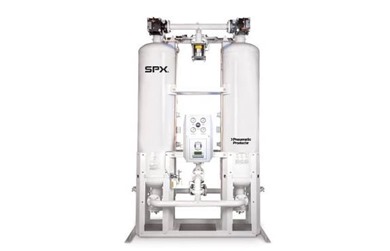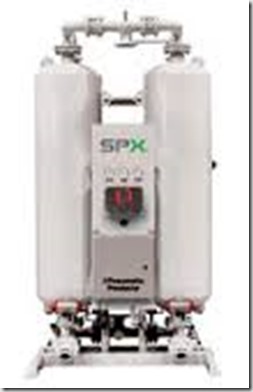Last weeks post discussed the use and types of refrigerated air dryers. This week we begin a review of the 2nd most popular type of compressed air dryer, the regenerative type. As several different types of regenerative (desiccant) dryers are available, this weeks post will cover the general aspects of the desiccant dryer and the heatless type of regenerative dryer.
These dryers use a desiccant, (typically activated alumina (which adsorbs the water vapor in the air stream. A distinction needs to be made between adsorb and absorb. Adsorb means that the moisture adheres to the desiccant, collecting in the thousands of small pores within each desiccant bead. The composition of the desiccant is not changed, and the moisture can be driven off in a regeneration process by applying dry purge air, by the application of heat, or a combination of both. Absorb means the material that attracts the moisture is dissolved in and used up by the moisture. Absorption takes place in a deliquescent desiccant type dryer.
Regenerative desiccant dryers normally are of twin tower construction. One tower dries the air from the compressor while the desiccant in the other tower is being regenerated after the pressure in the tower has been reduced to atmospheric pressure. Regeneration can be accomplished using a time cycle or on demand by measuring the temperature or humidity in the desiccant towers or by measuring the dew point of the air leaving the on-line tower.
You will find most all regenerative dryers with a stated flow rating at 100 PSIG and 100 degree F incoming air rating for pressure and temperature. The regenerative dryer can remain a viable option with higher or lower pressure and temperature requirements but caution must be used to size the dryer at the worst possible conditions. This being the lowest possible pressure and the highest possible temperature. A regenerative dryer is sized based on how many pounds of desiccant material must be incorporated into each tower such that it has the capacity to adsorb the water vapor load throughout the entire cycle. If the capacity of the desiccant is not adequate to adsorb all water vapor then the moisture that is not absorbed will be passed downstream. The reason for the caution is the moisture contained within the compressed air will vary greatly with higher or lower pressures and temperatures. Most especially temperature.
While it might not seem to be that important, a good rule of thumb is that for every 20 degree rise in compressed air temperature, the water load doubles! This means if the incoming air temperature is 120 degree F rather than the standard 100 degree F, the dryer would need to double in size. This can make a tremendous difference in your compressed air budget if a dryer has to double in size.
Advantages of Regenerative Desiccant Type Dryers include:
- Very low dew points can be achieved without potential freeze-up.
- Moderate cost of operation for the dew points achieved.
- Heatless type can be designed to operate pneumatically for remote, mobile or hazardous locations.
Disadvantages of Regenerative Desiccant Type Dryers include:
- Relatively high initial capital cost
- Periodic replacement of the desiccant bed (typically 3-5 years)
- Oil aerosols can coat the desiccant material, rendering it useless if adequate pre-filtering is not maintained.
- Purge air usually is required.
Heatless Regenerative Dryer
In the most common type of regenerative dryer, the heatless regenerative desiccant type, no internal or external heaters are used. Purge air requirement can range up to 18% of the total air-flow. The typical regenerative desiccant dryer has a pressure dew point rating of -40°F but dew points to -100°F can be obtained. Often when a regenerative type dryer is required, the heatless type is chosen for the the lower initial investment and the perceived lower operating cost as there is no external heater to consume electricity or steam.
This is however incorrect as the cost of operation is the power consumed by the compressor to generate the purge air requirements. Not only will the compressor have to produce the purge air but often, a larger compressor is required to meet both the plant air demand and the demand for regeneration air.
Let’s assume your plant requirements are 1000 SCFM at 100 PSIG. A typical oil flooded rotary screw compressor requirement will be 250 HP and will deliver 1218 ACFM @ 100 PSIG. We can’t use a 200 HP compressor as the delivery is only 980 ACFM which will not meet our demands. So we now need a heatless regenerative dryer that will handle 1218 ACFM. Looking at our book we find we can use a PPC model 1600DHA. While there is a 1200DHA that will accommodate 1200 SCFM it is slightly undersized and we don’t want to risk the plant dew point so we need to move to the larger size. It’s critical to remember that when determining the regeneration flow that this number must be based from the dryer capacity, not the actual flow rate to the dryer. In this case 18% of 1600 SCFM is 288 SCFM. Now we add the 1000 SCFM that our plant requires plus the 288 SCFM that we will need for regeneration air and our total air from the compressor has to be 1288 SCFM. At this point we see that our 250HP compressor will not deliver enough flow to maintain both the plant requirement and the regeneration flow requirement so we will have to increase our purchased compressor to a 300HP model that will deliver 1480 SCFM.
The majority of clients will feel like they could stay with the 250 HP compressor and use the PPC model 1200DHA dryer as we are only over the max flow by 18 SCFM. Honestly, most compressed air sales companies would also tell the customer this would work just fine and it very well may. A point to consider is in the event the aftercooler gets slightly fouled on the compressor and the discharge temperature increase 5 degrees then our water load increases (by our previous rule of thumb) to 25% greater. Since we are already slightly over our max flow rating on the dryer and now increase the water load by 25% the chances for a catastrophic failure from water contamination is extremely likely.
Also, to think of the cost of operation of the dryer – you are running a 50-60 HP air compressor just to produce the regeneration flow for the dryer. I would state this is not an economical situation!
Advantages of Heatless Regenerative Desiccant Type Dryers include:
- Very low dew points can be achieved without potential freeze-up.
- Can be designed to operate pneumatically for remote, mobile or hazardous locations.
- Low initial investment cost compared to other regenerative types
Disadvantages of Heatless Regenerative Desiccant Type Dryers include:
- Periodic replacement of the desiccant bed (typically 3-5 years)
- Oil aerosols can coat the desiccant material, rendering it useless if adequate pre-filtering is not maintained.
- Purge air is required and can be quite expensive.
Next week we’ll look into the various types of heated regenerative dryers.



